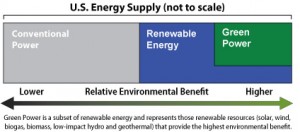Renewable Energy and Green Power — What’s the Difference?
Green Power Defined
Renewable energy and green power — what’s the difference?
In short, not all sources of power generation have the same environmental benefits and costs. So we thought we would take a brief amount of time to explain the difference in renewable energy and green energy.
If you will look at the graph below, you will see that Green power is a subset of renewable energy and it represents those renewable energy resources and technologies that provide the highest environmental benefit. EPA defines green power as electricity produced from solar, wind, geothermal, biogas, eligible biomass, and low-impact small hydroelectric sources. Customers often buy green power for avoided environmental impacts and its greenhouse gas reduction benefits.
Green power sources produce electricity with an environmental profile superior to conventional power technologies and produce no fossil-fuel based greenhouse gas emissions. EPA requires that green power sources must also have been built within the last 15 years in order to support “new” renewable energy development.
Renewable energy includes resources that rely on fuel sources that restore themselves over short periods of time and do not diminish. Such fuel sources include the sun, wind, moving water, organic plant and waste material (eligible biomass), and the earth’s heat (geothermal). Although the impacts are small, some renewable energy technologies have an impact on the environment. For example, large hydroelectric resources can have environmental trade-offs associated with issues such as fisheries and land use.
Conventional power includes the combustion of fossil fuels (coal, natural gas, and oil) and the nuclear fission of uranium. Fossil fuels have environmental costs from mining, drilling, or extraction, and emit greenhouse gases and air pollution during combustion. Although nuclear power generation emits no greenhouse gases during power generation, it does require mining, extraction, and long-term radioactive waste storage.
Reposted from the EPA Green Power Partnership
Another Source of green energy is preserving what you already use. Electrical motors draw a lot of current to get them started but once they are at operating speed that amperage reduces. The excess energy gets wasted after the motor gets to operating speed and is similar to static. It is released into the atmosphere as an Electromagnetic Field (or EMF’s).
With each family in America consistently adding more and more electrical devices in their homes their, what was once a comfortable, rate of exposure has now turned harmful and should be removed to prevent our children and pets from becoming over exposed to these harmful EMF’s. One of the best and most economical ways to remove EMF’s from your home, and save you 12 to 30% on your electric bill is the Green Power Box. You can get more information at www.greenpowerbox.com

